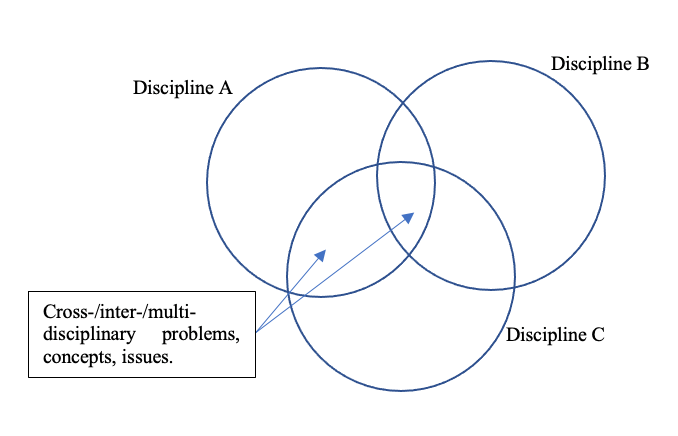Conceptualization of Transdisciplinary Education in HKBU
Approved by HKBU Senate in January 2025
Download a PDF copy
I. Objective and Rationale
This white paper provides a framework for development and implementation of transdisciplinary (TD) teaching and learning (T&L) at HKBU through an articulation of the meaning of TD within this context. It is motivated by the need to ensure quality T&L curricular development at HKBU that authentically matches the spirit of TD approaches (Bernstein 2015, Philipp & Schmohl 2023, and notably UNESCO 1997). It is intended to assist colleagues who wish to enrich the TD T&L culture at our university and nurture talent that would help build a sustainable society for the future. HKBU recognizes that the rapidly changing interconnective nature of today's world requires students to develop new ways of TD thinking and being (Bammer 2013, Ramley 2014, Rigolot 2020, among others).
II. HKBU’s Concept of Transdisciplinary
HKBU’s understanding of TD encompasses the crossing of disciplines and of sectors. One way of understanding this is to consider the sets of diagrams given below.



Without delving into the subtle differences between terms like “inter-”, “cross-”, and “multi-” as illustrated in Diagrams (1) and (2), the main thing about TD education is the “transcendental” perspective. The perspective illustrated in Diagram (3) covers the academic fields found in universities and also the interaction between academia, industry and the various sectors that make up our society. TD also sees the disciplines and the interaction to be evolving with reference to the dynamic nature of our society.
TD education at HKBU can thus be understood as partnering with students to develop abilities to appreciate and translate concepts, ideas, issues across disciplines and sectors so as to facilitate solutions to problems and concerns that do not respect these boundaries (Smyth 2017). Such students may either be generalists or specialists, it is their ability to apprehend and appreciate different perspectives and different concerns that is the goal of TD education.
TD approaches draw up essential critical skills of conceptualization, understanding, problem-posing, problem-solving, evaluation, reflecting, perspective-taking and collaboration. To claim that something as TD in HKBU would require that it is consistent with Diagram (3). TD approaches are not superior over any other approaches, discipline-specific, sectorial, or overlapping in one way or another. All approaches and perspectives have inherent strengths and values that cannot be displaced by any other. HKBU’s TD T&L aims at enriching student learning experience and in cultivating TD talents, not at displacing extant pedagogies or methodologies.
III. Qualifying a Curriculum as Transdisciplinary
Given the conceptualization in Diagram (3), a course, programme, or any curricular item can be evaluated for how well it qualifies as TD through a checklist such as the one below:
Checklist for TD Course/Second Major/Programme
- Explicit relation to a pertinent global issue, for instance, in relation to the United Nations’ Sustainable Development Goals;
-
Content coverage that includes multiple perspectives across
- (a) disciplines, and/or
- (b) sectors,
- Participation/Collaboration across academic disciplines;
- Participation/Collaboration across sectors (including and/or beyond academia);
- Problem solving with experiential learning (including service learning)
The checklist needs to be interpreted rigorously against any proposed course/programme, as reported in Gillis et al (2017), to ensure that it qualifies as TD in alignment with HKBU’s conception of TD education.
CITED WORKS
Bammer, G. (2013). Disciplining interdisciplinarity: Integration and implementation sciences for researching complex real-world problems. ANU Press.
Bernstein, J. H. (2015). Transdisciplinarity: A review of its origins, development, and current issues. Journal of Research Practice, vol. 11.1 article R1. Retrieved from http://jrp.icaap.org/index.php/jrp/article/view/510/412
Gillis, D., Nelson, J., Driscoll, B., Hodgins, K., Fraser, E., & Jacobs, S. (2017). Interdisciplinary and transdisciplinary research and education in Canada: A review and suggested framework. Collected Essays on Learning and Teaching, 10, 203-222.
Philipp, T., & Schmohl, T. (eds.) (2023). Handbook Transdisciplinary Learning. transcript Verlag.
Smyth, T.S. (2017). Transdisciplinary Pedagogy: A Competency Based Approach for Teachers and Students to Promote Global Sustainability. Journal of Interdisciplinary Studies in Education, 5(2), 64-72.
Ramley, J. A. (2014). The changing role of higher education: Learning to deal with wicked problems. Journal of Higher Education Outreach and Engagement, 18(3), 7-22.
Rigolot, C. (2020) Transdisciplinarity as a discipline and a way of being: Complementarities and creative tensions. Humanities and Social Sciences Communications, 7(1). https://doi.org/10.1057/s41599-020-00598-5
UNESCO (1997) Educating for a sustainable future: a transdisciplinary vision for concerted action. EPD-97/CONF.401/CLD1